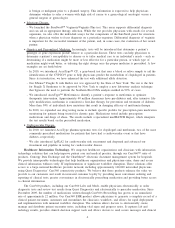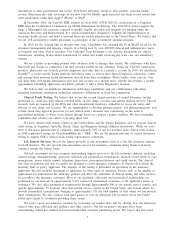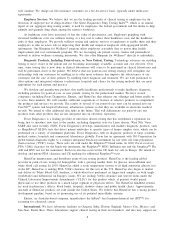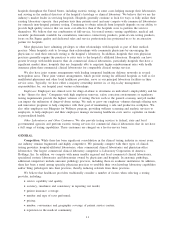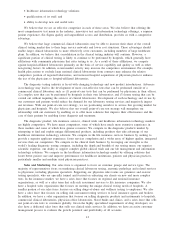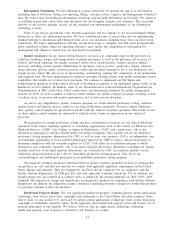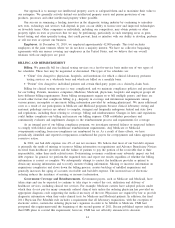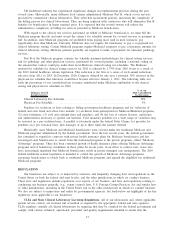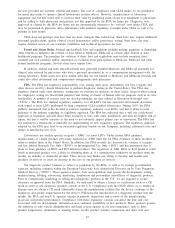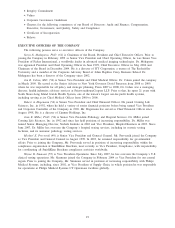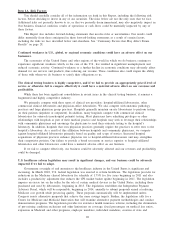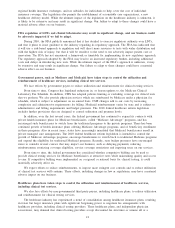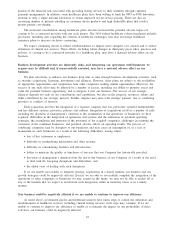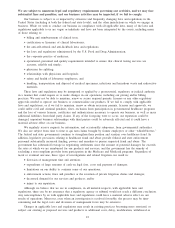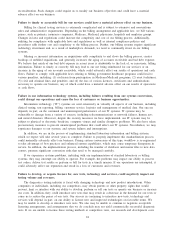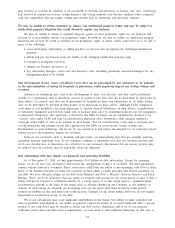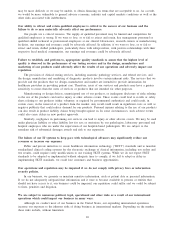Quest Diagnostics 2010 Annual Report Download - page 19
Download and view the complete annual report
Please find page 19 of the 2010 Quest Diagnostics annual report below. You can navigate through the pages in the report by either clicking on the pages listed below, or by using the keyword search tool below to find specific information within the annual report.services provided are accurate, reliable and timely. The cost of compliance with CLIA makes it cost prohibitive
for many physicians to operate clinical laboratories in their offices. However, manufacturers of laboratory
equipment and test kits could seek to increase their sales by marketing point-of-care test equipment to physicians
and by selling to both physicians and patients test kits approved by the FDA for home use. Diagnostic tests
approved or cleared by the FDA for home use are automatically deemed to be “waived” tests under CLIA and
may be performed in physician office laboratories with minimal regulatory oversight under CLIA as well as by
patients in their homes.
CLIA does not preempt state laws that are more stringent than federal law. State laws may require additional
personnel qualifications, quality control, record maintenance and/or proficiency testing. State laws also may
require detailed review of our scientific validations and technical procedures for tests.
Fraud and Abuse Rules. Federal anti-kickback laws and regulations prohibit making payments or furnishing
other benefits to influence the referral of tests billed to Medicare, Medicaid or certain other federal or state
healthcare programs. The penalties for violation of these laws and regulations may include monetary fines,
criminal and civil penalties and/or suspension or exclusion from participation in Medicare, Medicaid and other
federal healthcare programs. Several states have similar laws.
In addition, federal and state anti-self-referral laws generally prohibit Medicare and Medicaid payments for
clinical tests referred by physicians who have a personal investment in, or a compensation arrangement with, the
testing laboratory. Some states also have similar laws that are not limited to Medicare and Medicaid referrals and
could also affect investment and compensation arrangements with physicians.
FDA. The FDA has regulatory responsibility over, among other areas, instruments, test kits, reagents and
other devices used by clinical laboratories to perform diagnostic testing in the United States. The FDA also
regulates clinical trials (and, therefore, testing that we perform for sponsors of those trials), drugs-of-abuse testing
for employers, testing for blood bank purposes and testing of donors of human cells for purposes such as in vitro
fertilization. A number of esoteric tests we develop internally are first offered as laboratory-developed tests
(“LDTs”). The FDA has claimed regulatory authority over all LDTs, but has exercised enforcement discretion
with regard to most LDTs performed by high complexity CLIA-certified laboratories. During 2010, the FDA
publicly announced that it has decided to exercise regulatory authority over LDTs, and that it plans to issue
guidance to the industry regarding its regulatory approach. The FDA has indicated that it will use a risk-based
approach to regulation and will direct more resources to tests with wider distribution and with the highest risk of
injury, but that it will be sensitive to the need to not adversely impact patient care or innovation. The FDA has
not announced a framework or timetable for implementing its new regulatory approach. The regulatory approach
adopted by the FDA may lead to an increased regulatory burden on our Company, including additional costs and
delays in introducing new tests.
Laboratories use analyte specific reagents (“ASRs”) in some LDTs. Under current FDA guidance,
manufacturers of certain products previously marketed as ASRs must file for FDA clearance of these products in
order to market them in the United States. In addition, the FDA recently has increased its scrutiny of reagents
and kits labeled Research Use Only (“RUO”) or Investigational Use Only (“IUO”) and has announced that it
plans to issue guidance on RUO and IUO labeled products. The regulation of ASR, RUO or IUO products could
result in increased product cost, a delay in obtaining them or, if a manufacturer withdraws its products from the
market, an inability to obtain the product. These factors may hinder our ability to develop and market new
products or services or cause an increase in the cost of our products or services.
Our diagnostic product business is subject to regulation by the FDA, as well as by foreign governmental
agencies, including countries within the European Union who have adopted the Directive on In Vitro Diagnostic
Medical Devices (“IVDD”). These agencies enforce laws and regulations that govern the development, testing,
manufacturing, labeling, advertising, marketing, distribution and post-market surveillance of diagnostic products.
Prior to commercially marketing or selling most diagnostic products in the U.S., we are required to secure
clearance or approval from the FDA. Similarly, we may need to obtain a license or certification such as a CE
mark in order to sell diagnostic products outside of the U.S. Compliance with the IVDD allows us to market in
Europe once we obtain a CE mark (obtainable where the manufacturer certifies that the device conforms to the
regulatory and quality requirements for the device). Following the introduction of a diagnostic product into the
market, the FDA and non-U.S. agencies engage in periodic inspections and reviews of the manufacturing
processes and product performance. Compliance with these regulatory controls can affect the time and cost
associated with the development, introduction and continued availability of new products. These agencies possess
the authority to take various administrative and legal actions against us for non-compliance, such as fines,
product suspensions, submission of warning letters, recalls, product seizures, injunctions and other civil and
16


